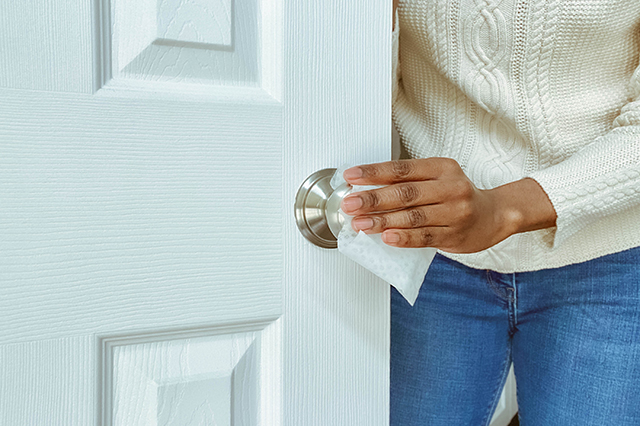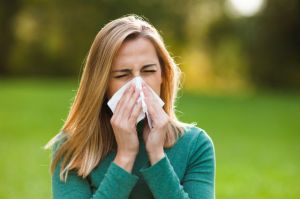Is it clean? This is the question most of us are asking ourselves on the few occasions we now leave the house (gloved and face masked), and about anything we bring home.
With cases of COVID-19 circulating since the beginning of March, we’re all battling an invisible enemy.
The advice we keep hearing from the CDC and other health officials is to practice social distancing and stay home as much as possible, keep at least 6 feet away from others, use a cloth face cover and wash hands frequently. But maybe that doesn’t seem like quite enough.
Samara Geller, a senior research and database analyst who manages the healthy cleaners database for Environmental Working Group, offers a few extra pointers.
When it comes to knowing how to sanitize and disinfect, not all surfaces are created equal. The granite countertop in your kitchen, for instance, is much easier to subject to thorough sanitizing than that box of cereal on the shelf at the grocery store or the handle of the pump at the gas station.
How to Sanitize Your Hands
“For most surfaces you encounter on the go, it may be more practical to employ thorough hand sanitizing and hand washing strategies than to effectively sanitize or disinfect nonporous surfaces with antimicrobial cleaning wipes or travel-size sprays,” Geller says. “This is because sanitizers and disinfectants are only fully effective when used in a manner consistent with their labeling. This may be easier said than done.”
So, glove up, do your shopping, pump your gas and keep your hands strictly away from your face while you do it. “If you’re worried about the transfer of germs from frequently touched surfaces to your face, and if you can’t wait until you arrive home or get to a public restroom to wash your hands with soap and water, hand sanitizer works in a pinch,” says Geller.
Thoroughly wet and rub your hands with a hand sanitizer that contains a minimum of 60 percent ethyl alcohol, also known as ethanol, and let them air dry. If you’re out and about, sanitize before getting into your car and touching the steering wheel.
The gold standard, which you can employ when you get home, is to wash your hands (for at least 20 seconds or two “Happy Birthday” choruses). Those groceries, by the way, don’t need to be sanitized as long as you’re washing your hands. The U.S. Food & Drug Administration’s guidelines on food safety and COVID-19 state that food packaging is considered a low-risk source of transmission.

How to Sanitize Surfaces
In your home, focus on sanitizing surfaces you come in frequent contact with, including doorknobs, handrails, faucets and light switches. When you are ready to tackle those (and that countertop), do it right. “Selecting the right product and observing the adequate level of surface saturation and contact time with the surface, are critical — and often overlooked — steps to achieving proper effectiveness,” Geller says.
EWG has you covered on the “right product” score, as it recently published a list of 16 safe and effective products to guard against coronavirus. These are all U.S. Environmental Protection Agency-registered disinfectants that have research to back up their pathogen-killing claims. Geller advises looking for an EPA registration number on cleaning products you purchase. Active ingredients that are preferred include hydrogen peroxide, ethyl alcohol (ethanol), citric acid, L-lactic acid, caprylic acid (octanoic acid) and thymol.
How to Disinfect Surfaces
While sanitizing reduces the amount of germs on a surface, disinfecting kills them.
When you’re ready to disinfect a surface, first thoroughly read the label on your disinfectant. Make sure the product is safe to use on the surface you have in mind, and wear gloves if that’s indicated. Open windows or doors so there is good ventilation in the area where you’re working.
First, clean the surface with soap and water to remove visible dirt or grease. Next, spray or sponge on the disinfectant so that the surface is thoroughly wet, and make sure it stays visibly wet for the length of time indicated on the product label’s directions for use before you rinse or wipe the area dry. This could mean anywhere from 30 seconds to 10 minutes, depending on the product. It could take multiple sprays or wipe-downs to keep the surface wet long enough.
If your product of choice is a disinfecting wipe, do not be tempted to re-use it. Geller says this could be dangerous. To keep your wipes as effective as possible, be sure to reseal the package after each use, and store the wipes in a cool place out of direct sunlight.
Note that wipes are considered a safe way to sanitize your smartphone – which might just be the most frequently touched surface in your world. Apple says on its website that you can use disinfecting wipes on its phones. Other companies recommend spraying a nonabrasive, alcohol-based (at least 70% isopropyl alcohol, and never straight rubbing alchohol) cleaner on a microfiber cloth to clean your phone.
With the right disinfecting products and techniques, you can make sure that while you’re safer at home, your home is clean and safe.
For more ways to stay germ-free and healthy, check out our tips on how to sanitize your car and clean your suitcase.
18 Thoughts on “Keep It Clean: Expert Tips on How to Sanitize”
Leave A Comment
Comments are subject to moderation and may or may not be published at the editor’s discretion. Only comments that are relevant to the article and add value to the Your AAA community will be considered. Comments may be edited for clarity and length.

















Thank you.
Recommend a good sanitizer to wipe down surfaces. Kitchen and or desk surfaces.
Hi Richard,
Here is a link to a list of recommended cleaners:
Thank you! – MM
Helpful
Thanks, Alice! I’m glad you saw value in this article. – KG
In this time of the Coronavirus, what is the best soap to use on car leather without buying a specialty car product? Is Saddle Soap good -the stuff I already have for my shoe leather?
Hi William! Here is a response from our resident Car Doctor: Simple soap and water will work just fine. Mix up one part soap and four parts water. Once mixed together agitate it into a sudsy mix and clean with more suds than water. Use a soft brush to work the soapy mixture into the nooks and crannies and wipe off with a clean microfiber towel. According the medical professionals, the coronavirus breaks down easily with soap and water. Do not use, bleach or hydrogen peroxide and as with any cleaning start in an inconspicuous spot to check for color fastness.
Thank you for your question! If you find this helpful please share! Best of luck. MM
Please name the products or something we can make
Hi Barbara,
You can find a list of 16 effective and safe products to use here.
Thank you! – KG
Great ideas but supplies are impossible to purchase and many are lacking funds now.
If you have bleach, mix it according to directions. also, if you have a dollar store, hopefully they will have bleach.
You have to be very careful to purchase the right kind of bleach. For example, the so-called Splash-Less Bleach is not a disinfectant — it’s just a laundry whitener. And the disinfectant bleach has been impossible to find, along with disinfectant wipes and other disinfectant products. I recently found real bleach at my local hardware store (ordered over the phone, contact-free curbside pickup), along with a product called Spray Nine, which is EPA approved. As well, regular cleaning wipes, while they will not kill the virus, will remove it from a solid surface and then you toss the wipe in the trash and wash your hands.
It would’ve been helpful if the Best products were named
Also, a bleach and water solution mixed according to instructions will work just fine.
Hi Linda,
You can find the best products here.
Thank you! MM
Very helpful!
Hi Chrisoula! Thank you for your kind words. Please share, that is the highest compliment! -MM
Some times recommendations do not make sense when you are not able to buy disinfectants, clorox, etc. Also nobody write about the importance of tcleaning the shoes